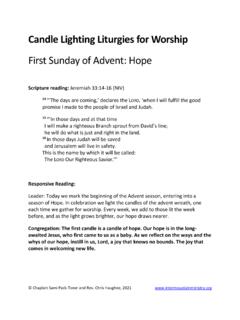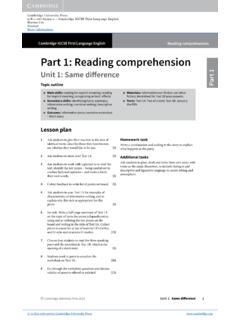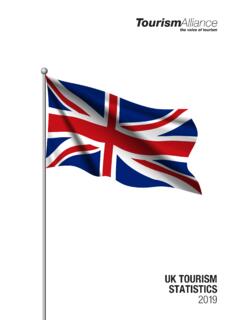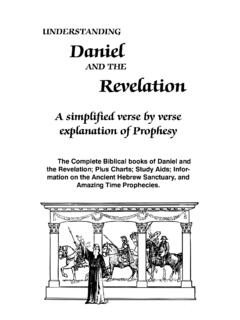Transcription of Yoruba Art & Culture
1 Yoruba Art & CulturePhoebe A. Hearst Museum of AnthropologyUniversity of California, BerkeleyYoruba Art and CulturePHOEBE A. HEARST MUSEUM OF ANTHROPOLOGYPHOEBE A. HEARST MUSEUM OF ANTHROPOLOGY UNIVERSITY OF CALIFORNIA AT BERKELEYBERKELEY, CA 94720-3712 510-642-3682 and Designed by Nicole MullenEditorsLiberty Marie WinnIra JacknisSpecial thanks to Tokunbo Adeniji Aare, Oduduwa Heritage 2004 PHOEBE A. HEARST MUSEUM OF ANTHROPOLOGY AND THEREGENTS OF THE UNIVERSITY OF CALIFORNIA. ALL RIGHTS of Spellings and Pronunciation of Yoruba Structure and , 10 Yoruba Story of How the Yoruba Kingdoms Were Colonization and Independence of , Agriculture and and and Calabash , 23 Creation , 25 Music and Festivals and Egugun Thinking , 32 Lists of , 34 Sources ART AND CULTUREPHOEBE A.
2 HEARST MUSEUM OF ANTHROPOLOGY4 ABSTRACT not a realistic or exact copy of somethingADZE a tool used to cut and shape woodBABALAWOa diviner in Yoruba society CASSAVA a starchy root similar to a sweet potatoCOMPOUND a building or buildings where people live set off and enclosed by a barrierDEITY divine character or being of a supreme nature, a god or goddessDIASPORA a scattering of a people from their original homelandECONOMY the management of the resources of a countryEXPORT to ship goods to other countries or places for sale, exchangeGOODS materials made to be soldIMPORT to bring or carry in from an outside source, especially to bring in (goods or materials) from a foreign countryfor trade or saleINDIGOa blue dye obtained from various plantsKOLA NUTS brownish seed, about the size of a walnut containing caffeineMILLETa grain used as food for humans and fowls ORISAa god or deityPALM OILan oil obtained especially from the crushed nuts of an African palm (Elaeis guineensis)
3 Used to make soaps,chocolates, cosmetics, and candlesPETROLEUM crude oil found in the ground which is refined and used to power things like cars and gas stovesPLANTAINa starchy form of the bananaREALMa region, sphere, or domainSHRINEany structure or place devoted to a saint, holy person, or deity, as an altar, chapel, church, or templeSORGHUMan edible cereal grassSTAPLEa basic or necessary item of foodTAROa stemless plant, farmed in tropical regions, for the edible tuberURBAN characteristic of the city or city lifeYAMa starchy root or sweet potatoWestern Spellings and Pronunciation Key of Yoruba WordsEsu: EshuIlesa: IleshaOlorun: OlrunOrisanla: OrishalaOrisa: OrishaSango: ShangoYORUBA ART AND CULTUREPHOEBE A. HEARST MUSEUM OF ANTHROPOLOGY5 Yoruba ART AND CULTUREPHOEBE A.
4 HEARST MUSEUM OF ANTHROPOLOGY6 AFRICAA frica is the second largest continent in theworld after Asia. It is an extremely diverse place with many different cultural groups andlandscapes. There are tropical forests, grasslands, plains, anddeserts. There are 54 countries in Africa, over800 million people, and over 1,000 different languages A. HEARST MUSEUM OF ANTHROPOLOGYN igeria's population is multi-ethnic with morethan 250 groups having a variety of customs, religions, traditions, and languages. The country smajor ethnic groups, which make up about two-thirds of the total population, include the Hausaand Fulani in the north, the Yoruba in westernNigeria, and the Igbo in eastern Nigeria. Othergroups include the Kanuri, Nupe, and Tiv of thenorth, the Edo of the south, and the Ibibio-Efikand Ijaw of the southeast.
5 Although English is theofficial language of the country, Hausa, Igbo, andYoruba are commonly spoken. About half of thepopulation living in the north are Muslim; another40 percent, in the south, are Christian. Theremaining population follows traditional has been the capital city of Nigeria since1991. Nigeria is more than twice the size ofCalifornia. The Republic of Niger borders it to the north, the country of Cameroon to the east,the Republic of Benin to the west, and theAtlantic Ocean to the south. The Niger Riverruns through the country. Nigeria has a coastlinemade up of sandy beaches, behind which lies abelt of mangrove swamps and lagoons. North of the coastal lowlands is a broad hilly region,with rain forest in the south, and savanna in the north.
6 behind the hills is the great plateau of Nigeria, a region of plains covered largely with savanna. This area becomes scrubland in the north. Yoruba ART AND CULTURE7 Lagos, Nigeria, 1960 NIGERIAP eopleLandPHOEBE A. HEARST MUSEUM OF ANTHROPOLOGYA lthough Nigeria's natural resources include vastamounts of oil and gas reserves, the country suf-fers from poverty. Nigeria has endured warfare andcivil unrest since it became an independent of military regimes and political corruptionhave left the country with economic has one of the largest populations of allthe African countries with an estimated 104 million people. About 60 percent of the popula-tions live in rural areas. However, the capital citiesare crowded as a result of people leaving thecountryside in search of social and economic well-being.
7 Although agriculture is an importantpart of Nigeria's economy it is difficult for thecountry to produce enough food to keep up withthe rapid population growth. Although Nigeria stillexports goods it must also import some of thecountry s food in order to feed all of its 1999 democratic elections were held andOlusegun Obasanjo was elected. There is hopethat his leadership will turn Nigeria's economyaround. Even so, Nigeria still has many challengesto overcome before it can obtain a strong ART AND CULTURE8 Political Structure and EconomyPHOEBE A. HEARST MUSEUM OF ANTHROPOLOGYYORUBA ART AND CULTURE9 The Yoruba people live on the west coast of Africain Nigeria and can also be found in the easternRepublic of Benin and Togo. Because the majority of the slaves brought to the Americas were fromWest Africa Yoruban descendants can also be foundin Brazil, Cuba, the Caribbean, and the UnitedStates.
8 There are also many Yoruba currently livingin Europe, particularly Britain, since Nigeria wasonce a British colony. The Yoruba are one of thelargest cultural groups in Africa. Currently, there areabout 40 million Yoruba world-wide. The Yorubahave been living in advanced urban kingdoms formore than 1,500 years. They created a strong economy through farming, trading, and art production. Their outstanding and unique artistictraditions include woodcarving, sculpture, metalwork, textiles, and beadwork. Beaded bag (detail)Beaded Ibeji (twins)The Yoruba have one of the highest rates of twin births in theworld. Twins (ibeji) are consideredspecial children whose birth signifies good fortune. The loss ofa twin is considered a great misfortune. If a twin dies, themother has a memorial figuremade and the soul of the deceased twin is transferred to figure is then kept in thehome and the mother continues to take care of it.
9 She offers it foodand prayers weekly and performsmore elaborate rituals on thetwin s YORUBAPHOTOGRAPHS BY NICOLE MULLENPHOEBE A. HEARST MUSEUM OF ANTHROPOLOGYWest Africans, such as the Yoruba , have lived inurban societies and have produced extraordinaryart work since the 5thcentury BC. During thistime, the Yoruba began to use iron to createmetal tools and weapons such as machetes, axes, and hoes. These tools made it easier for the Yoruba to farm the land. They planted cropsincluding yams, their staple food. They also harvested the seeds from the palm oil tree. Theseeds from this tree produce a vegetable oil thatis used for cooking. Kola nuts were also grownand harvested. Soon the Yoruba began tradingwith neighboring areas for rice and to increased agriculture, the Yoruba commu-nity began to grow in size and large towns were created.
10 They arranged their communities by clanlines, or extended families. Families who had thesame ancestors lived next door to each other inlarge compounds. An elder was put in charge asthe head of the compound. Towns became organized by the type of work that people did. For example, farmers lived close by blacksmithswho made the tools they needed to farm theirland. By 600 ADthe Yoruba were ruled by kingsand chiefs. Yoruba ART AND CULTURE10 Forestland, NigeriaRoyal palace compound, Oyo, Nigeria, 1960 PHOEBE A. HEARST MUSEUM OF ANTHROPOLOGYY oruba KingdomsThere were about 20 Yoruba kingdomsat one time with a different king rulingover each one. Ife was known as thecenter of cultural and religious life. Oyo was the strongest kingdom withthe largest military and political kingdom of Oyo was close to theNiger River.





